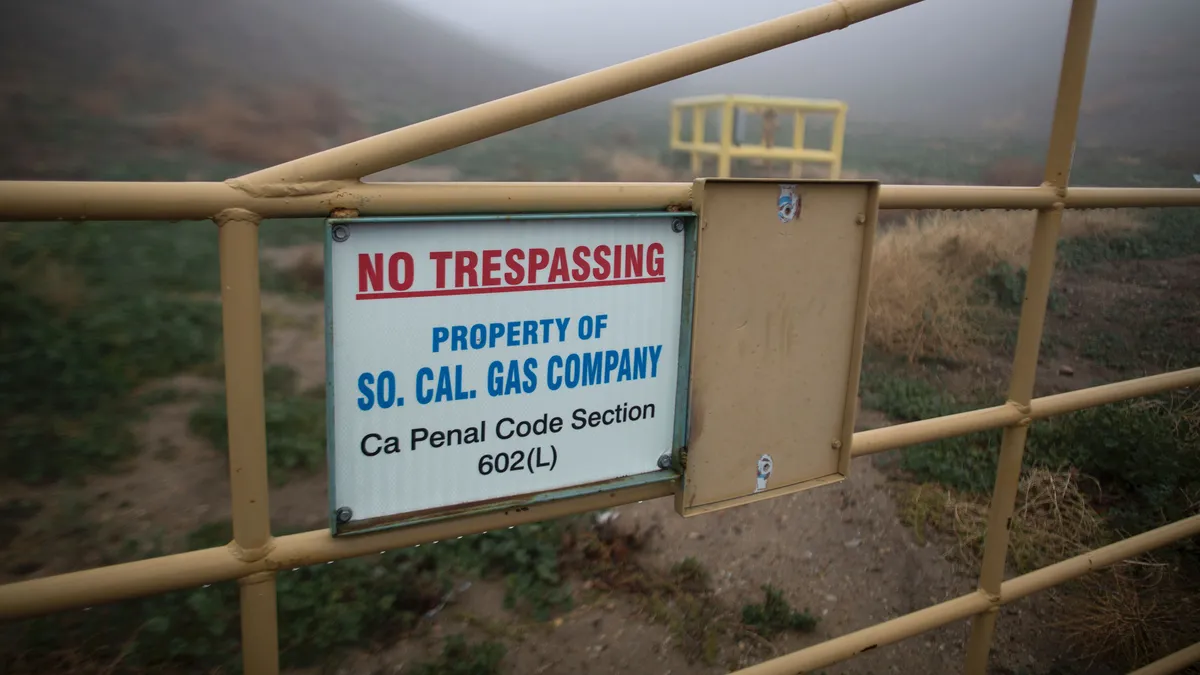Dive Brief:
- California regulators last week approved a decision that allows Southern California Edison (SCE) to spend an additional $8.7 million on demand response programs this summer to mitigate for potential natural gas shortages stemming from the Aliso Canyon natural gas leak.
- The decision allows SCE to expand its summer discount program, continue peak demand rebates, and pushes it to speed up development of a Demand Response Auction Mechanism (DRAM), among other elements. In the same decison, regulators also approved 2017 demand response programs for the state's IOUs, authorizing $56.28 million in spending for SCE, $59.9 million for PG&E, and $23.8 million for SDG&E.
- The additional demand response funding comes as part of a broader push to open up alternative resources and enhance efficiency in the wake of the nation's worst-ever gas leak. Last month, regulators approved expedited storage procurements for SCE and called for enhanced efficiency programs.
Dive Insight
Discovered last October, the gas leak has left the Southern California Gas' Aliso Canyon gas storage facility with less than one-fifth of its capacity. In response, Gov. Jerry Brown called on the CPUC in January to take action to ensure reliable supplies of gas and electricity.
In April, a joint report from the CPUC, the state energy office, the California ISO and the Los Angeles Department of Water & Power warned that customers could have to curtail their usage or even face blackouts for up to 14 days this summer if no action is taken. They outlined an 18-point action plan for the region, and regulators in early May called on SCE to increase efficiency spending as a mitigation measure.
Last month, regulators said even those measures may not be enough to mitigate reliability concerns and directed SCE to identify and procure fast-responding storage resources that can be put on the grid quickly.
Now, the CPUC is turning to the demand side of the equation, authorizing additional funding for SCE demand response programs in the Los Angeles region. Under the ruling, the utility will be able to spend an extra $3.2 million for its Summer Discount Plan, which allows customers to save on their bills if they let SCE interrupt their air conditioning during peak events.
SCE had a goal of signing up 1.6 million residential and commercial customers to the program by 2017, Greentech Media reports, and regulators told the utility to focus its recruitment efforts on the LA Basin.
Additionally, the decision will let SCE continue its Peak Time Rebate program through the end of the year, restart its Demand Bidding Program, and continue its Base Interruptible Program and Agricultural Pumping Interruptible programs with enhanced funding. The utility had proposed to eliminate the peak rebate program, saying savings to customers and in energy conservation have been weak.
Under the ruling, SCE will also get extra funding to expand rebates for programmable thermostats for 28,000 additional customers and enroll them in peak demand management programs.
Last but not least, the decision also directs SCE to expedite development of a custom Demand Response Auction Mechanism (DRAM) for regions affected by the Aliso Canyon leak.
Designed to integrate aggregated demand response into state wholesale markets, the DRAM pilot programs at the state's three IOUs are slated to get underway this summer, taking bids for about 40 MW of DR between them. Though SCE asked regulators to wait until the results of those pilots came in, regulators said that was "not an option" in light of potential gas shortages, and directed the utility to devise a custom DRAM program for the affected regions.
In an effort to get the custom DRAM up and running by next summer, the order puts SCE under a tough timeframe. The utility is directed to file the first request for offers under the new auction in August, and the first deliveries are scheduled to commence on May 1, 2017.
Other resources are looking to capitalize on the Aliso Canyon shortage as well. The Solar Energy Industries Association, Greentech Media reports, is asking regulators to keep a long-running commercial PV program at SCE up and running, though the utility had asked to close it after receiving less than 2 MW of projects in its most recent solicitation.
Meanwhile, solar PV projects could bring more energy to the region, particularly during the same hot summer afternoons when grid demands are expected to reach their peak. That’s the rationale of a proposal from the Solar Energy Industries Association (SEIA), asking the CPUC to keep SCE’s long-running Solar Photovoltaic Program (SPVP) up and running.
Started in 2009, the SPVP was aimed at bringing about 500 megawatts of commercial PV projects on-line, with the utility and third-party developers getting half. But after receiving only 1.8 megawatts of projects under its most recent solicitation, SCE asked the CPUC for permission to end the program, even though about 25 megawatts of capacity remain.
The solar lobbying group is also pushing legislation to allow gas-fired water heaters to be replaced with grid-responsive electric water heaters paired with rooftop solar systems. Often overlooked as a low-tech solution, a number of utilities, particularly rural co-ops have begun to embrace demand response and efficiency programs focused on water heaters, taking advantage of their ubiquity in the home and ability to act as a makeshift "battery in every basement."













